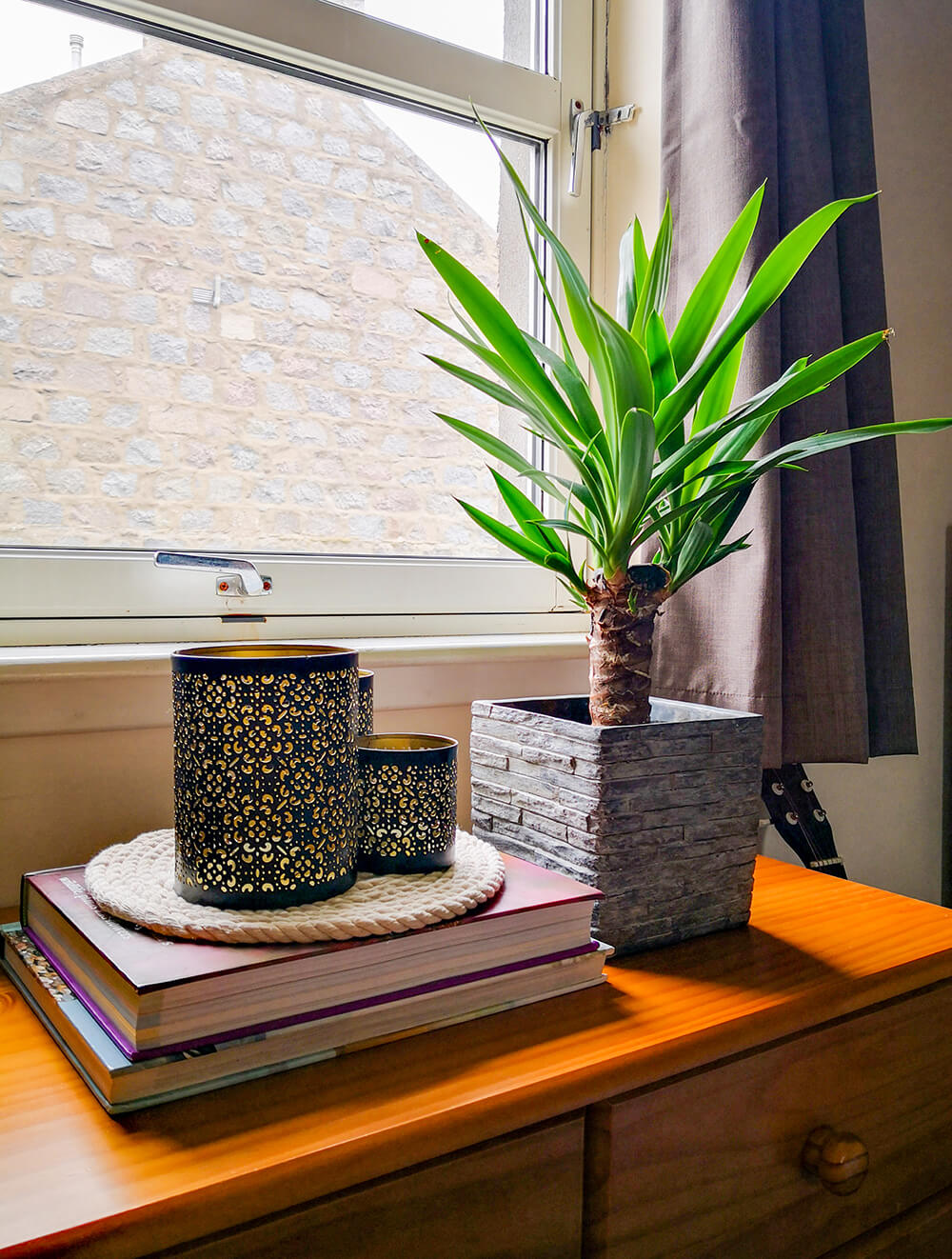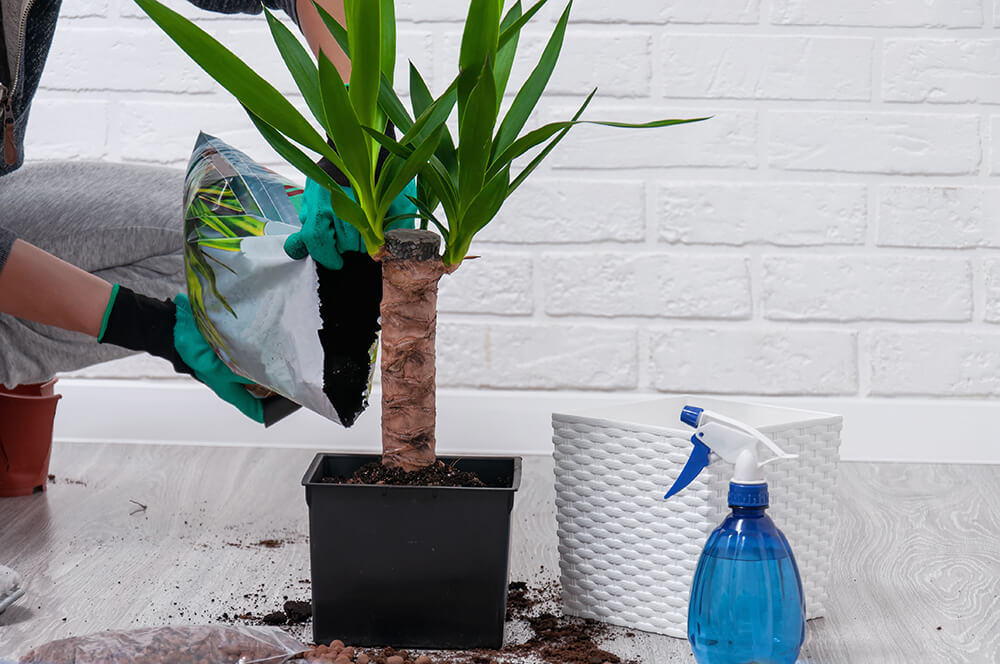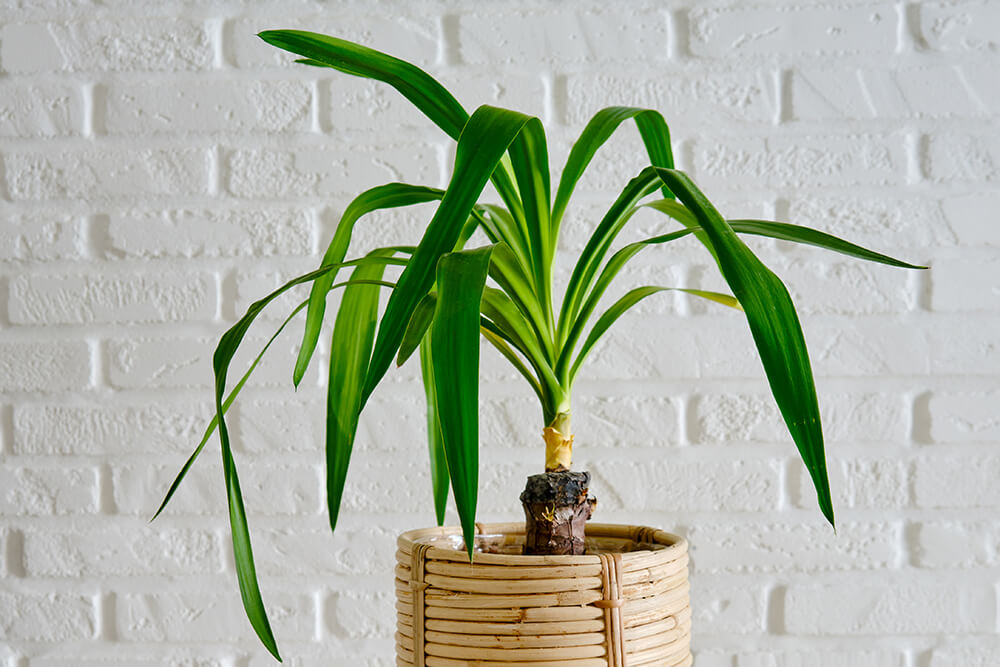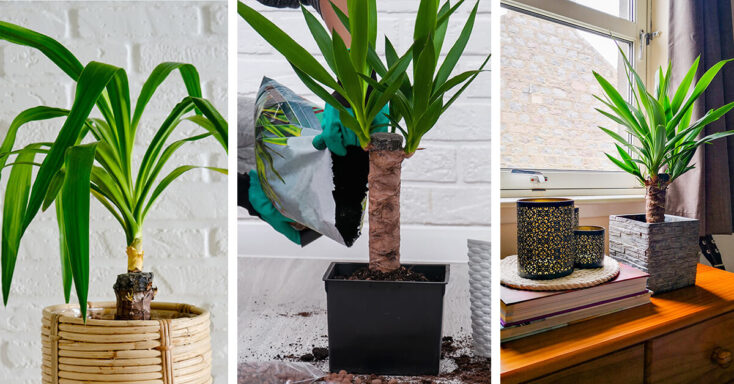When looking for a plant that lives for a long time, Yucca can grow for 20-50 years under the right conditions. Indoors, you don’t live for so long, only five years.
Most Yucca have no stems. Rather, there are rigid rosette leaves shaped like swords. The rosettes bear a crown of white flowers. If their appearance pleases you, this article how to grow and care for indoor yucca plants successfully.
Key Takeaways
- Yucca Trees have more diversity than you expect, giving you more options when shopping.
- These plants are drought-tolerant. So, if you miss a watering, don’t sweat it.
- A healthy indoor Yucca Tree will produce “pups” from which you can propagate new plants at home.
- With a little intel, you can grow and care for Yucca Trees with little fuss.
Yucca Assessment
When you look at an outdoor Yucca, you would never think this huge, thorny plant has anything in common with a common vegetable. Asparagus is part of the Yucca family. When the Yucca puts up new stalks in the spring and summer, the similarity to asparagus is unquestionable. The truth is that Yucca has a fascinating family tree. Some of their cousins include spider plants and bluebells!
Factoid: Look closely at a Yucca leaves. They have a waxy coating that isn’t just for show. It helps them conserve water loss and evaporation. Each leaf has a built-in channel, directing water into the roots. This helps the Yucca maintain the necessary levels of moisture as needed.
Yucca flowers are not shy. They sit on a tall stem throne. Mostly they appear white, but you may see other shapes and colors. They appear in spring and summer, looking like a bell. Come fall, as the flowers are dying, their berries, stuffed with black seeds, fall free from the tree.
Joshua trees are a species of Yucca (surprise!). In California, there is a law protecting the Joshua Tree. Weather Changes and human developments threaten this tree, and its numbers are rapidly declining. The legislation safeguards the native Yucca plant, including poaching.
Indoor Yucca Plant Care
Indoor Yucca plants require proper care for them to grow into maturity. Adequate water and sunshine are vital factors, as well as having rich soil. Without the correct nutrients, without which the Yucca begins dying.
If you periodically forget to water your plant, the Yucca is very forgiving. It is drought-tolerant. It’s not uncommon for a Yucca to endure well without water for a few weeks. Having said that, finding a healthy watering pattern for your Yucca supports lively blossoming.
Before buying a Yucca, inspect your garden space. Yucca needs full to partial sun. Without light, the plant becomes spindly. That space also needs to contain well-drained soil or the roots can become soggy and prone to disease.
They used peeled and ground roots for soap and shampoo. Folklore claims when you shampoo your hair with Yucca suds, it helps stave off baldness. The natural fibers of the Yucca become baskets and cords.
How to Tend Your Yucca Plant’s Needs

Let’s review 6 of the basic needs for your Indoor Yucca Plant.
- Fertilizer is the “soul food” for Yucca. During the growing season, use a liquid controlled-release product (10-10-10). Apply it once a month.
- Light: The Yucca needs indirect light, but the plant will become thin if it’s not getting enough. Growth is minimal. Conversely, if you see brown tips on the plant accompanied by white spots on the leaves, your plant is getting too much sun.
- Pups: Your mother plant may develop pups around the cane at the soil level. These can become new plants if you wish. Trim them off in the fall and have a pot prepared. You want only to take the mature, dark green pups. Removing these allows the plant to direct more energy into the roots.
- Soil (just dig it!); Sandy is The best type of soil for your indoor yucca. You really don’t need fancy soil. Just get a normal potting mix to which you add coarse sand for proper drainage.
- Temperature (hot hot hot!): In their natural habitat, Yucca live in temperatures upward of 90F, and then slowly dropping to 30F at night. So, if your house’s heat changes, you have no worries. If you have a humidifier you can put near the Yucca, it will help greatly.
- Water: Take care. Only water your Yucca once a week in spring and summer, and only if the soil’s dried out. When winter arrives, slow your watering schedule. Even with an indoor plant, following natural cycles helps with well-being.
Yucca Pollination: There is a special insect called the Yucca Moth, with good reason. As they travel from plant to plant, they unwittingly transfer pollen. They also lay eggs tucked safely within flowers. The sharp Yucca leaves act as protection.
Yucca Shopping Guide
You’ll be happy to know that there are 50 species of Yucca. Each has something different to offer. Differences include the fruit, flower, and leaf traits. There are even ones with white or yellow stripes.
- Adam’s Needle: Grows only 3 feet tall with the base mirroring the same size. This particular pant has impressive, tall stalks. The cluster of flowers may grow to 8 feet, so perhaps it’s best suited to an entryway or spaces with headroom.
- Adam’s Needle, Color Guard. A spectacular Yucca with variegated leaves. The curly threads in the leaves turn rosy-colored come winter. Mature plant height: 2-3 feet.
- Adam’ Needle Excalibur: A Yucca with blue-green, stiff leaves. In between the foliage, you’ll see cute curly firmaments. The flowers are in a large cluster of cream to white. Mature height 5-feet.
- Aloifolia (Harrimaniae): Bearing the nickname of Spanish Bayonet, the pointy leaves live up to the name. Take care with these. They tend to bite. If you have small children, do not add this to your indoor garden.
- Spineless: This is a popular plant because it lacks those sharp barbs common in many other Yucca. Indoors this Yucca grows to a height of about 5 feet. The Spineless yucca is ornamental. Flowers grow on 2-foot-long spears.
- Weak Leaf: The name for this Yucca comes from how this plant grows. The leaves drop and bend as if exhausted. Perfect for indoor gardening, Weak Leaf grows to about 2 feet. However, You need a little space because the spread can grow to 5 feet.
Propagating Yucca
Yucca isn’t difficult to propagate if you want to expand your indoor collection. The easiest approach is using the offshoots from the plant. Gather pups when they are green. Slice the pup from the mother plant, making sure to get some of the parent’s roots. Have a new pot set up as you would for replanting. The pups root quickly, and you’ll start seeing new growth.
There are varieties of yucca with edible flowers and fruits. You’ll find them frequently in Mexican cuisine. You can fry, stew, bake, and saute them. When cooking with Yucca, you can adorn your table with Yucca flowers. So much prettier than parsley.
Watering Techniques for Indoor Yucca Plant

Established Yucca plants don’t require a lot of water. This is especially true if you’ve planted them in a pot with drainage holes and proper media. When the topsoil dries, it’s time to water, on average, 2-3 times monthly. If you see your plant’s leaf tips brown, it may be getting too much water—under-watering results in yellowing leaves.
When it is time to water, make sure the Yucca gets a good soaking. Let the excess water drain. Return it to its space, and wait until the next watering cycle.
Yucca: Succulent, Cactus, or Shrub?: TYuccas are, indeed, succulents. They are not cacti. Rather, Yucca is a shrub. Be careful around them as they have spiky leaves.
Yucca Potting and Repotting
You know your Yucca requires repotting when the root reaches the outer edge of the pot. Repotting is a step-up plan. Choose a pot that’s no more than 2” in diameter beyond the current container. Mix potting soil with some pebbles and sand. It is okay to let the Yucca become a little rootbound, so repotting every few years is fine.
When you repot, you give your Yucca fresh, nutrient-rich soil. The roots have room to breathe. Even if your plant hasn’t outgrown its space in two years, refreshing the soil’s still a good idea. Pay particular attention to the Yucca’s roots. Loosen them gently, but don’t go overboard. It can shock the plant. Speaking of which, watch for wilting leaves or discoloration. Move your plant to a slightly shadier spot and let it dry out.
Yucca is not “yuca.” Yuca plant (cassava) in the produce aisle may appear among the ingredient list for snack chips or desserts. The category for yuca is as a root vegetable, while the yucca root is not edible.
Yucca Pruning and Maintenance
Your indoor yucca may grow beyond the available space. Now you need to prune it. The easiest way to handle this is by putting down some paper and removing the Yucca from its container. Cut midway between the root and the top of the plant. Place the rooted end back into the media (this is an excellent opportunity to switch out soil). Tip: You can take the pieces cut off and put the wide end into the soil. It will grow a new plant.
When you’re just touching up the Yucca, use clean scissors. Take out dead stems or leaves. The offshoots at the base can come off, too. This helps keep size in check. Add a little fertilizer in your next watering session to avoid shock. It’s easiest to cut them after flowers fade. If your plant has been struggling, a gentle trim may help it bounce back.
Yucca Flowers: American settlers called Yucca flowers “lamparas de Dios,” meaning Lamps of God. The towers of white drooping panicles is an inspiring sight. Yucca flowers blossom once a year. Deadheading won’t encourage further blossoms. Just engage in cosmetic trims for upkeep.
Blooming and Resting Periods for Yucca Plant

Yucca blooms in late summer and goes dormant in winter or in sweltering summers. As the cooler months approach, yucca naturally stores more water in their leaves. Trust your plant. It dies back in season. Decrease the water throughout this period.
The Navajo people have a story about Yucca. They believe that the Sun God created yucca flowers. The Sun God planted a piece of himself in the soil. Yucca grew on that site. This blessing provided the Navajo with medicine and other resources for daily living.
Common Pests & Plant Diseases in Indoor Yucca Plants
You don’t have to sweat too much about insects in your Yucca. The most common culprits are mealybugs and aphids. Sometimes the agave bug moves in, loving the yucca’s juices. Brown scars on the leaves are a sign of agave plant bugs. Spray the plant with Neem OIl several times, monitoring for further damage.
Over-watering causes one yucca disease. Fungus creates gray mold and rots the base of the stem. When there are yellow and brown spots on older leaves, you likely have brown spot. Watering your plant at the bottom rather than overhead decreases the chances of brown spot. By the way, the advice of watering from the bottom applies to many yucca diseases.
Spiritual Meaning of Yucca. SYucca appears in Native rituals and ceremonies. Carrying Yucca affords protection from negative energies. The white color of the Yucca is associated with innocence and the soul’s journey toward enlightenment.
Troubleshooting Common Problems in Indoor Yucca Plants
There are some common problems that people report in their yucca plants.
- Yellowing leaves accompanied by a spongy stem. Nearly 80% of the time, this signals that your plant is getting too much water. Slow down your watering schedule, ensuring the soil dries out between applications. Additionally, make sure your plant has good drainage and ventilation.
- Light: White, brown, or yellow dots on the leaves. Your plants are getting too much light. Here your plant has a sunburn. Move your plant into a shadier location in the house. When it’s looking better, place it in an area with indirect sunlight.
- Pups: Curling Leaves. In this case, your yucca is too cold or too hot. Their comfort range is between 45F and 90F. You may see little red spots and dropping leaves. The resolution here is easy. Place the yucca in a temperature-friendly zone in your home.
If you dream of Yucca flowers, it may represent the need for personal growth and development. Think self-care. Your efforts result in prosperity and success.
Because Yucca is so hardy, they symbolize stamina during adversity. The additional message of this dream is “be wary.” There is a chance someone will betray you or that danger is nearby
Frequently Asked Questions About Yucca Plants Care and Keeping
How often do you water a yucca plant?
The rhizome of the Yucca holds water. So, wait until an inch of the topsoil is dry. Water every 10-14 days with the caveat of adjusting your schedule by the topsoil test. You can avoid over-watering by purchasing a pot with drainage holes.
Where is the best place to put a yucca plant?
Yucca likes the light, just not blazing. If your Yucca’s growth seems sluggish, it isn’t getting enough light. A southeast or southwest window is ideal. Do not crowd the Yucca in your indoor garden. It needs good ventilation. This rule is good to follow with your other plants, too. Spacing deters the spread of insects and disease.
Should you cut dead leaves off the yucca plant?
It’s natural for the leaves of a Yucca to turn brown as they age. Removing dead material is suitable for your plant’s growth and looks better. With the old foliage out of the way, it’s easier for young, green growth to begin. It isn’t necessary to do this, but it gives you an opportunity to shape the plant.
Will a yucca grow back if cut?
As a general rule, Yucca doesn’t need pruning. But, when you thin out the leaves, you encourage fresh growth. Look for older leaves or those that appear to be drying out. Prune in spring so the plant has time to recover before inclement weather arrives.
What can I do to yucca leaves when they turn yellow and brown end?
Most of the time, yellow and brown leaves mean you’re over-watering your plant. With indoor Yucca, it’s vital your plant has a container with several drain holes. And while you want to spread the love, always check the top inch of the soil for moisture. If it’s dry, it’s okay to water. A second possibility is the plant is simply aging. Pull the yellowed leaves with a gentle tug.
Summary
Yucca is not only an exciting addition to the indoor garden, but it offers an exotic feel. There aren’t many people who think of Yucca when visualizing houseplants. Nonetheless, they’re easy plants that endure some neglect with pride. Always take a survey of the indoor areas with indirect light for your plant, then shop accordingly.


